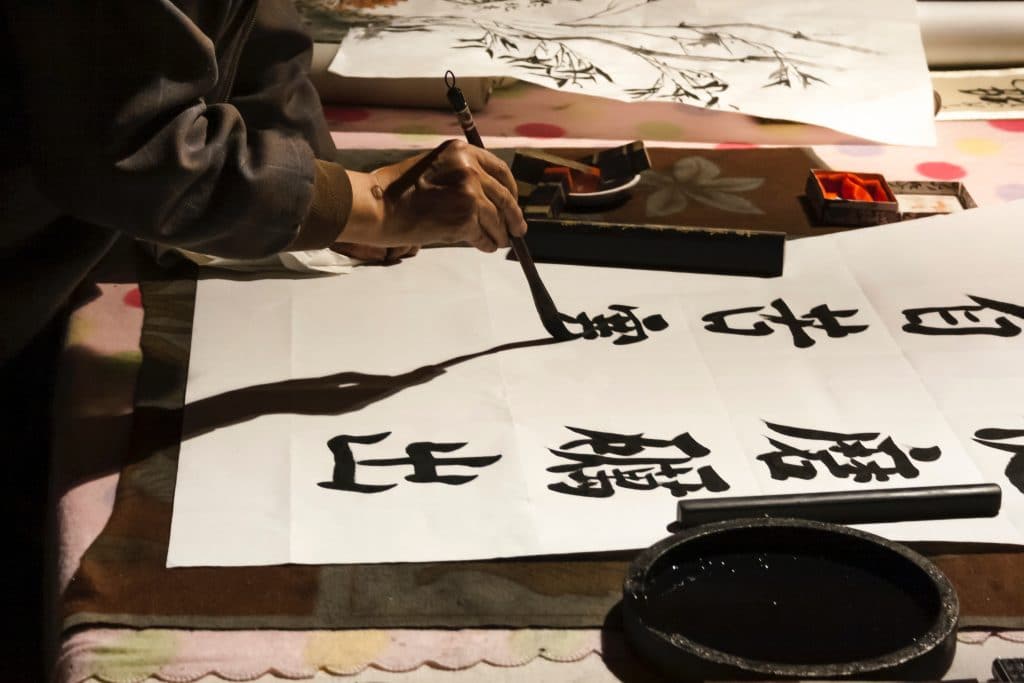
The art of Sho, Shodô, is the art of calligraphy or literally the way of calligraphy. It is an ancient art valued as a visual art (according to H.E. Davey) but also a form of ‘moving meditation’ and as a means to enhance concentration, willpower and poise. We witnessed this recently at the Art Gallery of NSW as Shotei Ibata, a Japanese living treasure at the age of 68, heaved the world’s largest calligraphy brush out of a bucket of ink (he almost couldn’t get the brush over the lip) and proceeded to sweep across a floor of paper which must have been about 4×6 meters in size. His state of balance was such that on his first failed attempt to lift the brush he smiled and laughed with the audience without becoming distracted from his task and the connected state that he had connected with prior to the performance. Meditation is a must for all performers of the art of sho and this is where the art becomes a mere extension of the seated meditative state. Later he told us that he never knew which calligraphic character he would draw or how he would do it – his aim was to become empty and allow that emptiness to create form.
For more information about Shodô please read the programme from Shotei Ibata’s exhibition at the Beowulf Galleries in Sydney:
The Art of Sho, modern Japanese brush art, has been developed as a fine art through the desire in the past to write aesthetically those Chinese characters which were originally invented in China some three thousand years ago as linguistic symbols for communication. These symbols, together with Buddhism, were introduced into Japan between the fifth and sixth centuries. The art of Sho is essentially an abstract art. It is not representational nor is it merely the art of refined handwriting. Characters as used in the art of Sho are no more than a convention and merely provide a field for artistic expression. Their meaning, denotative or connotative, is not considered important except in special cases in which the artist chooses a particular character because it is the best suited to the size of the paper to be used and its configuration is the most appropriate for its self expression.
Suppose the artist has chosen the character ‘kawa’ which means a river: it is composed of three vertical lines drawn from side to side. The artist is quite free to decide how thick and in what form each of these lines is to be , how they are to be spaced and with what force and speed they are to be drawn, That is the point of the art of Sho. I would like to emphasize that this is the art in which characters are used as motifs for artistic expression. One may question why characters are used. The answer lies in the beauty and variety of form – almost limitlessly varies and variable. The art of Sho is a formative art of lines and space in which time plays an important part. The artistic meaning of lines is created and determined by the pressure applied on the brush and the direction and speed of its movement. The rhythm thus produced is not a mere rhythm of forms but a dynamic representation of the very rhythm of life as it moves on.
When a work of Sho is created on a piece of paper, the limited space of the paper is transformed into an infinite space wherein the rhythm of life moves. Where strokes of the brush cross or overlap each other an effect of depth is produced. A work of Sho possesses an exquisite three dimensional quality.The graceful art of black and white possesses a sentiment that may be thought of as a mystic manifestation of the human spirit. In recent times, particularly from the influence of the avantgarde movement, we find ourselves inclined towards stressing the formative function of our art at the expensive of the form of the characters. This new art, known as Bokushu, which is derived from the art of Sho, is not based on characters but is a much more abstract form of self expression. I believe that the art of all people is ultimately a genuine expression of human life and not an art of portraying objects. The art of Sho, which has at its very basis the desire to express the human spirit, is therefore, an art which has an appeal to all.
Bronwen and Frans Stiene are the co-founders of the International House of Reiki and co-authors of The Reiki Sourcebook, The Japanese Art of Reiki, Your Reiki Treatment, The A-Z of Reiki Pocketbook and the Reiki Techniques Card Deck. Bronwen and Frans teach in the USA, Europe and Australia. Visit the Courses page to find a course near you.


Comments 1
I think in any form of art whether its drawing, painting, poetry etc. if one just go with that flow without any preconceived thought and preparation it can take a amazing turn some thing we some times even cannot believe if it was done by us.
Amazing article on how this art is like a moving mediation and is must for this art form.
I particularly this quote-
“his aim was to become empty and allow that emptiness to create form”
thank you